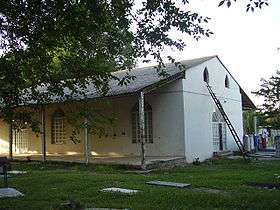Battle of Fort Tabarsi
Shaykh Ṭabarsí, or more correctly the Shrine of Shaykh Tabarsí, was the location of a battle between the forces of the Shah of Persia and the Bábís (followers of the Báb) over the period October 10, 1848 to May 10, 1849, when the prince resorted to a plan of betrayal to capture the remaining Bábís. It is located in Mazandaran Province, Iran.

Leading up to the Battle
Mullá Husayn-i-Bushru'i, one of the most prominent Bábís, marched with 202 of his fellow disciples, under instructions from the Báb, from Mashhad to the Shrine of Shaykh Tabarsí with the Black Standard raised, fulfilling an Islamic prophecy.[1] The mission was most likely proclamatory but possibly also to rescue another Bábí leader, Quddús, who was under house arrest in Sárí. After being rebuffed at the town of Barfurush the group took up making defensive fortifications at the Shrine of the Shaykh. Upon arriving at the shrine, the Bábís, numbering a little over 300 according to Bábí and Baháʼí sources and according to court historians, were now under imminent attack from government forces.
A scholarly review finds reasonable support for between 540 and 600 people present including over a hundred villagers who joined locally after those that arrived from across the country. A census of the Bábís who had traveled some distance to the Shrine shows 14 major former clerics of Islam, 122 minor former clerics of Islam, 12 nobility or high government officials, 5 wholesale merchants, 9 retail merchants, 39 guild tradesmen, 6 unskilled laborers, 6 peasants, and 152 unclassified.[1] Different sources have some similarities of which cities/provinces they came from — the highest numbers coming from Isfahan, Boshruyeh, Miyami, and Bahnemir, though 33 locations are listed among the places of origin of the participants.
Sources describe the building of the fort as a matter of self-defence. The Bábí's spent many months under attack in the fort, resorting to eating the leather of their own clothes to remain alive.
During the battle
Over the weeks that followed, more and more Bábís joined the fort with numbers rising to perhaps six hundred.[2] Most notable of the late arrivals is Quddús who joined after being released by Tabarsí Bábís on October 20.
Baháʼís see the battle, which was led by Mullá Husayn, as a heroic stand against oppressive government forces that lasted several months.
At last, having finally been reduced to near-starvation by the encirclement, the Bábí defenders surrendered on the guarantee of safe passage — a guarantee that was immediately violated, with most of the former “garrison” massacred on the spot on May 10.[3][4]
After the battle
It is believed that eight of the disciples of the Báb also called the Letters of the Living were killed in the series of battles:
- Mullá Husayn-i-Bushru'i
- Muhammad-Hasan-i-Bushru'i
- Muhammad-Baqir-i-Bushru'i
- Mullá Mahmud-i-Khu'i
- Mullá Jalil-i-Urumi
- Mullá Ahmad-i-Ibdal-i-Maraghi'i
- Mullá Yusif-i-Ardibili
- Mullá Muhammad-'Aliy-i-Qazvini
Quddús was taken prisoner in the city of Barfurush. There the high priest rallied the townsfolk into a vicious frenzy. Quddus was then left to the hands of the mob who beat him to death on May 16, 1849. What remained of Quddus' body was gathered by a friend and buried nearby.[5]
The battle is considered the most important upheaval of the Bábí religion because the Báb himself instructed Mullá Husayn-i Bushru'i to initiate it with raising the "Black Standard" as well as a call for support of the collective initiative of Bábís, the episode included two leading figures of the religion in Mulla Husayn and Quddús and overall nine out of eighteen of the Letters of the Living, and actually reached a widespread response from across the country.[1] No other upheaval the Bábís suffered had this pattern of importance in it.
It was mentioned in some French language newspaper accounts from the Journal de Constantinople in March 1849.[6]
See also
- Conference of Badasht one of the other major events of the Bábí period.
Notes
- Momen, Moojan (May 1983). "The Social Basis of the Babi Upheavals in Iran (1848-53): A Preliminary Analysis". International Journal of Middle East Studies. 15 (2): 157–183. doi:10.1017/s0020743800052260. JSTOR 162988.
- Smith 1999
- http://www.executedtoday.com/2016/05/16/1849-quddus/
- Quddús
- The Dawnbreakers pg. 411
-
- Nouvellees de Perse, Journal de Constantinople, March 24, 1849, p. 1, bottom fourth column, above middle
- Aux détails sur la Perse…, Journal de Constantinople, March 29, 1849, p. 1, bottom second column, top third
References
- Amanat, Abbas (1989). Resurrection and Renewal. Cornell University Press, 124 Roberts Place, Ithaca, New York 14850. ISBN 978-0-8014-2098-6.
- Mehrabkhani, Ruhu'llah (1987). Mulla Husayn: Disciple at Dawn. Los Angeles: Kalimát Press. ISBN 978-0-933770-37-9.
- Nabíl-i-Zarandí (1932). Shoghi Effendi (Translator) (ed.). The Dawn-Breakers: Nabíl's Narrative (Hardcover ed.). Wilmette, Illinois, USA: Baháʼí Publishing Trust. ISBN 978-0-900125-22-5.
- Smith, Peter (1999). A Concise Encyclopedia of the Baháʼí Faith. Oxford, UK: Oneworld Publications. ISBN 978-1-85168-184-6.
- Zabihi-Moghaddam, Siyamak (2002). "The Babi-State Conflict at Shaykh Tabarsi". Iranian Studies. 35 (1–3): 87–112. doi:10.1080/00210860208702012.